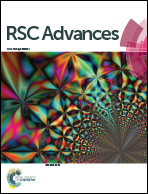Iodine–PPh3-mediated C3-sulfenylation of indoles with sodium sulfinates†
Abstract
3-(Alkylsulfanyl)- and 3-(arylsulfanyl)indoles were efficiently prepared by the reaction of indoles with sodium sulfinates mediated by iodine–PPh3 in ethanol. The salient features of the present protocol are simplicity, high efficiency, non-anhydrous conditions, environmentally friendly reagents and solvent, and short reaction time.


 Please wait while we load your content...
Please wait while we load your content...